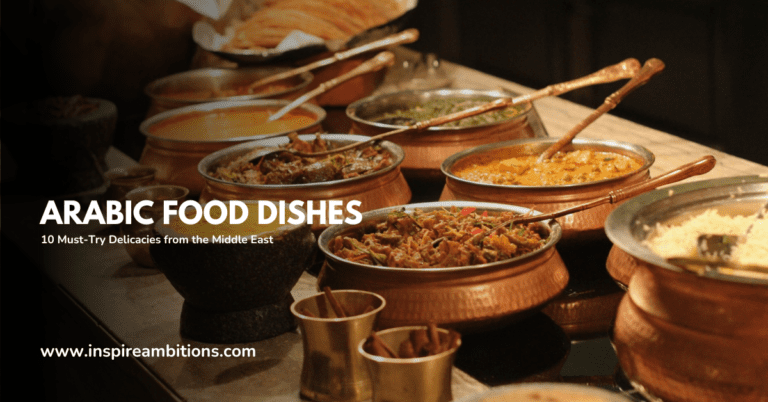Bebidas Árabes – Um Guia Completo de Bebidas Populares no Oriente Médio
Ao mergulhar no mundo das bebidas árabes, você descobrirá uma variedade de bebidas refrescantes e saborosas que não só são perfeitas para vencer o calor, mas também oferecem um sabor autêntico do Oriente Médio. Com uma rica história de receitas e ingredientes tradicionais, essas bebidas são mais do que apenas matar a sede; são um testemunho das muitas culturas e regiões que constituem esta parte fascinante do mundo.
Uma bebida popular para experimentar é Laban Ayran, uma bebida saborosa à base de iogurte que traz inúmeros benefícios à saúde, incluindo resfriar o corpo e matar a sede. No lado mais doce do espectro, você encontrará Limonana, uma tentadora mistura de limão e hortelã, que serve como uma deliciosa guloseima congelada para ajudá-lo a relaxar durante uma tarde quente de verão.
Ao explorar os sabores e histórias por trás dessas bebidas, você aprofundará seu apreço pelas tradições culinárias árabes e encontrará novas maneiras de se manter revigorado. Do suco de romã da região do Levante ao suco de gengibre e à Limonana do Oriente Médio, há uma bebida árabe para todos os gostos e ocasiões.
Então vá em frente e sacie a sua curiosidade, mergulhando no mundo refrescante das bebidas árabes.
Antecedentes históricos das bebidas árabes
Na rica história do mundo árabe, uma variedade de bebidas tem tido destaque, mostrando as práticas culturais únicas em diferentes regiões. O consumo histórico de álcool é proibido no mundo árabe-muçulmano devido à proibição islâmica do consumo de álcool.
O Alcorão Sagrado proíbe o vinho, mas não menciona explicitamente outras bebidas fermentadas. Com este pano de fundo, muitas bebidas árabes evoluíram como bebidas não alcoólicas para aderir aos princípios islâmicos.
Uma importante bebida histórica na cultura árabe é Café árabe. Acredita-se que a evidência mais antiga de consumo de café remonta a um pastor de cabras etíope chamado Kaldi, que observou a mudança de comportamento de suas cabras após consumir frutos de cafeeiro. Hoje, o café árabe é uma parte essencial dos eventos sociais e religiosos no mundo árabe.
Outra bebida tradicional popular é Chá de menta magrebina (Ataay) que é uma bebida diária no Norte de África, especialmente em Marrocos e na Tunísia. Feito de chá verde e hortelã, este chá é conhecido por trazer benefícios à saúde, incluindo quebrar a gordura e ajudar na perda de peso.
É importante reconhecer que a própria palavra “álcool” tem origem no termo árabe “al-koél”, que se refere a um pó fino utilizado como cosmético, em vez de definir o significado contemporâneo associado às bebidas alcoólicas.
Em resumo, o contexto histórico das bebidas árabes ilustra a profundidade da influência cultural e da adesão religiosa que moldou a variedade de bebidas apreciadas hoje em todo o mundo árabe.
Tipos de bebidas árabes
As bebidas árabes, ricas em tradição e sabores regionais, vêm em variedades quentes e frias. Nesta seção você encontrará uma seleção de bebidas geladas refrescantes para matar a sede e bebidas quentes quentes para acalmar os sentidos.
Bebidas Quentes
Chá Árabe:
Esta bebida saborosa varia em todo o Oriente Médio. Na Líbia, o chá árabe é acompanhado de amendoim, enquanto Marrocos é famoso pelo seu chá de menta magrebino. A Tunísia gosta de chá preto e, depois das refeições, as pessoas costumam tomar chá de sálvia (maramia) para ajudar na digestão e eliminar gases ou azia.
Bebidas geladas
Laban Ayran (لبن):
Uma saborosa bebida à base de iogurte apreciada em todo o Oriente Médio, Laban Ayran é servido frio e traz inúmeros benefícios à saúde. Ele esfria o corpo, reduz a sensação de sede e possui probióticos úteis.
Limon ou (e) nana (hortelã) – Limonana:
Esta é a versão árabe de uma deliciosa limonada de menta congelada. Feito com suco de limão, folhas de hortelã, açúcar, gelo e água, Limonana é uma mistura rápida e fácil de preparar. Com certeza irá refrescar você em um dia quente de verão.
Batido de data:
Uma variação dos milkshakes tradicionais, o milkshake de tâmaras é uma alternativa saborosa e nutritiva. Rico em açúcares naturais, fibras e vitaminas, é um resfriamento perfeito tratar no Oriente Médio aquecer.
Suco de Gengibre:
Repleto de propriedades que aumentam a imunidade, o suco de gengibre fresco é perfeito para se refrescar durante os meses de verão. Complete o suco de gengibre com hortelã e zaatar para adicionar uma explosão de sabor extra.
Aproveite essas bebidas árabes para mergulhar nos sabores vibrantes da cultura do Oriente Médio, ao mesmo tempo que se beneficia de seus atributos naturais refrescantes ou calmantes.
Bebidas Árabes Populares
A cultura árabe é rica em sabores e tradições, e as bebidas desempenham um papel significativo nos eventos sociais e na vida cotidiana. Nesta seção, exploramos algumas bebidas árabes populares que você pode saborear em vários ambientes.
Café Árabe
O café árabe, também conhecido como “qahwa” ou “gahwa”, é um símbolo crucial da hospitalidade e um elemento essencial na cultura árabe. Muitas vezes servido em ocasiões especiais e como um gesto de boas-vindas, este café é feito a partir de grãos de café verdes levemente torrados e aromatizado com cardamomo. Geralmente é apreciado sem açúcar ou leite e comumente servido em xícaras pequenas chamadas “finjan”.
Chá Árabe
Os países árabes têm preparações de chá distintas, variando de região para região. Uma variedade popular é o Karak Tea, também conhecido como Chai Karak. Originária dos Emirados Árabes Unidos, esta bebida picante e quente é uma variante local do chá masala. Preparada com folhas de chá, ervas indianas e especiarias como canela, gengibre, erva-doce e cardamomo, é uma bebida deliciosa, muitas vezes apreciada no café da manhã ou como estimulante durante o dia.
Tamar Hindi
Tamar Hindi, uma bebida picante e refrescante feita de tamarindo, é uma delícia absoluta durante os meses quentes de verão. Esta bebida naturalmente agridoce é amplamente apreciada no Egito e na região do Levante. Tamar Hindi pode ser apreciado gelado ou com gelo, e seu sabor picante combina bem com um toque de limão para um toque cítrico extra.
Sóbia
Sobia é uma bebida tradicional egípcia não alcoólica feita de cevada ou arroz e aromatizada com açúcar, coco e especiarias como canela e cravo. É uma bebida refrescante, branca leitosa, normalmente apreciada durante os meses mais quentes. Sobia não é apenas deliciosa, mas também rica em nutrientes e é conhecida pelas suas propriedades refrescantes, o que a torna a bebida perfeita para o verão.
Métodos de preparação
Na hora de preparar drinks árabes, aproveite os sabores e aromas únicos que essas bebidas têm a oferecer. Aqui estão alguns métodos para fazer você mesmo essas guloseimas refrescantes e saborosas.
Tamar Hindi, um suco à base de tamarindo, tem sabor amargo geralmente adoçado com açúcar. Para fazer esta bebida, é necessário abrir um tamarindo e mergulhá-lo em água. Depois de algumas horas, peneire a mistura para retirar qualquer resíduo de polpa e, em seguida, adicione açúcar e água de acordo com o nível de doçura e espessura de sua preferência. Sirva com gelo para uma bebida gelada revitalizante.
Outra bebida árabe popular é a Limonana, uma limonada de menta congelada. Para fazer esta mistura fácil e deliciosa, basta combinar o suco de limões espremidos na hora com folhas de hortelã, açúcar, gelo e água no liquidificador. Misture os ingredientes até atingirem uma consistência pastosa e sirva imediatamente para matar a sede, refrescante e energizante.
Se você adora café, o café árabe oferece um toque distinto à sua bebida normal. Em uma panela ou briki, misture água, açúcar, café moído e cardamomo. Aqueça a mistura em fogo médio, deixando ferver, depois reduza um pouco o fogo e deixe ferver até atingir a intensidade desejada. Despeje cuidadosamente o café em uma xícara, permitindo que o pó assente antes de saborear sua xícara revigorante.
Para uma bebida mais forte, o coquetel árabe combina vodka, tequila branca, gim, rum light, triple sec, suco de cranberry e suco de abacaxi. Comece colocando todos os ingredientes em uma coqueteleira com gelo. Agite vigorosamente para misturar os ingredientes e depois coe o coquetel em um copo furacão. Aproveite esta bebida colorida e potente com canudo.
Lembre-se, ao preparar essas bebidas, ajuste sempre os sabores de acordo com suas preferências gustativas. Quer seja um pouco mais de açúcar para o Tamr Hindi ou um pouco mais de suco de abacaxi no coquetel árabe, confie no seu paladar e crie uma experiência de bebida memorável.
Significado Cultural das Bebidas Árabes
As bebidas árabes têm grande importância no mundo árabe, pois simbolizam hospitalidade e generosidade. Ao visitar uma casa árabe, muitas vezes você será recebido com uma xícara quente de café ou chá árabe, demonstrando a gentileza e o respeito do anfitrião pelos convidados.
No mundo árabe, servir café árabe é considerado um ato cerimonial de generosidade. Tradicionalmente, o café é preparado na frente dos convidados, com os grãos levemente torrados no fogo antes de serem triturados em um pilão e almofariz de cobre. Este ritual cria um senso de comunidade e experiência compartilhada, permitindo que os hóspedes participem de uma tradição consagrada pelo tempo.
O chá árabe também tem seu significado cultural, com diferentes variedades apreciadas em toda a região. Na Líbia, o chá é frequentemente servido com amendoim, enquanto no Marrocos o chá de menta magrebino é o preferido.
Na Tunísia, o chá preto é a bebida preferida. O chá de sálvia, chamado “maramia” em árabe, normalmente é servido após uma refeição para ajudar na digestão e eliminar gases ou azia. Cada um destes chás representa os costumes e sabores locais das respectivas regiões de onde são originários.
Além do café e do chá, outras bebidas tradicionais árabes, como o Salep (Sahleb), são apreciadas pelo seu calor e energia, principalmente no inverno. Salep é feito de lata, amido de milho, canela e água de flor de laranjeira, o que o torna uma bebida acessível e de fácil acesso para todos.
Ao deliciar-se com estas bebidas árabes, você não está apenas saboreando uma deliciosa bebida, mas também participando de uma rica experiência cultural rica em história e espírito comunitário. Cada bebida representa uma mistura única de sabores e hospitalidade de diferentes áreas do mundo árabe, tornando-as mais do que apenas um deleite refrescante.
Benefícios para a saúde das bebidas árabes
As bebidas árabes não são apenas refrescantes e deliciosas, mas também oferecem diversos benefícios à saúde. Vamos explorar algumas dessas bebidas tradicionais e suas vantagens.
Labão Ayran é uma bebida saborosa à base de iogurte popular nos países do Oriente Médio. Consumir esta mistura fria pode ajudar a regular a temperatura corporal, mantendo-o fresco e reduzindo a sensação de sede. Além disso, é conhecido por seus diversos benefícios à saúde, graças aos nutrientes encontrados no iogurte.
Chás árabes como Tomilho (Za'atar) e Cardamomo (Hal) também são cheios de benefícios. O chá Za'atar é conhecido por melhorar a memória e limpar o estômago, enquanto seu rico conteúdo antioxidante ajuda a prevenir o envelhecimento por dentro. O chá de cardamomo, por outro lado, não é apreciado apenas por seu aroma forte, mas também é comumente apreciado no mundo árabe devido aos seus inúmeros benefícios à saúde.
Uma bebida tradicional frequentemente apreciada durante o Ramadã é Suco de tamarindo. Feita a partir do tamarindo, esta bebida refrescante é repleta de nutrientes e seu efeito refrescante pode ajudar a aliviar a sede em dias quentes.
Outra bebida árabe bem conhecida é Qahwa ou café árabe. Acredita-se que Qahwa aumenta a resistência e reduz a sonolência, graças ao seu teor de cafeína. Como resultado, mantém o corpo ativo e pode até ajudar a tratar a insônia.
Por último, Suco de romã (Rumman) é uma escolha popular na região do Levante. Esta bebida gelada oferece inúmeros benefícios à saúde, devido aos diversos nutrientes encontrados na romã. Além disso, é relativamente fácil de preparar.
Em resumo, desfrutar de bebidas árabes pode não apenas saciar a sede e mantê-lo fresco, mas também proporcionar inúmeros benefícios à saúde. Não hesite em incorporar essas bebidas em sua dieta e colher os frutos.
Bebidas Árabes em Reuniões Sociais
Na cultura árabe, as reuniões sociais e as celebrações são frequentemente acompanhadas por uma variedade de bebidas tradicionais. Essas bebidas não apenas fornecem refrescos, mas também têm significado e simbolismo cultural. Ao explorar as bebidas árabes, você descobrirá que elas são uma parte essencial do tecido social da região.
Uma bebida árabe clássica servida em reuniões é Café árabe. Este café é preparado de forma diferente do típico café ocidental, apresentando uma mistura única de especiarias como o cardamomo, que lhe confere um sabor distinto. Servir café árabe em eventos sociais, como noivados ou casamentos, segue rituais específicos, cada movimento carregando um significado simbólico.
Outra bebida popular para desfrutar durante reuniões sociais é Labão Ayran. Esta bebida gelada e saborosa consiste em iogurte como ingrediente base e traz inúmeros benefícios à saúde. Conhecido por seu efeito refrescante no corpo e na redução da sede, o Laban Ayran é frequentemente servido durante os dias quentes de verão ou em eventos de lazer à tarde, ajudando os hóspedes a se sentirem revigorados.
Labão é outra bebida semelhante enraizada na tradição do Oriente Médio. É uma bebida suave à base de leite com base de leitelho. Rico em nutrientes, o Laban pode ser temperado com diversos temperos, enriquecido com tâmaras ou servido sem açúcar, dependendo das preferências e gostos pessoais. Assim como Laban Ayran, também é conhecido por seus efeitos refrescantes e hidratantes.
Para concluir, Bebidas árabes são parte integrante das reuniões sociais e eventos culturais no Oriente Médio. Eles não apenas fornecem refresco e nutrição, mas também simbolizam hospitalidade e tradição. Então da próxima vez que você for a um evento social árabe não deixe de saborear e apreciar essas bebidas' sabores únicos e significado cultural.
Tendências Futuras em Bebidas Árabes
Ao explorar o mundo das bebidas árabes, é essencial ficar de olho nas tendências futuras que podem moldar o mercado e influenciar suas escolhas. Nos últimos anos, tem havido um foco crescente em opções mais saudáveis, na sustentabilidade e na fusão de culturas quando se trata de comida e bebida.
Você pode esperar um aumento na demanda por alternativas mais saudáveis aos favoritos tradicionais. O uso de adoçantes naturais em vez de açúcar, bem como a incorporação de ingredientes mais ricos em nutrientes, como frutas e vegetais, continuarão a ganhar força. Além disso, leite e iogurtes vegetais, como leite de amêndoa ou aveia, podem se tornar alternativas populares em bebidas como o Laban.
A sustentabilidade desempenhará um papel significativo no futuro das bebidas árabes. Os consumidores estão a tornar-se mais conscientes do seu impacto no ambiente e tendem a procurar produtos com menor pegada de carbono e embalagens plásticas mínimas. Os produtores podem passar a utilizar materiais e métodos ecológicos, concentrando-se em ingredientes locais e promovendo uma abordagem do campo à mesa.
À medida que a globalização continua a encorajar a mistura de influências culturais, você provavelmente notará uma diversificação de sabores e ingredientes nas bebidas árabes. Esta fusão de tradições poderá levar à criação de bebidas novas e inovadoras que combinem o melhor das diferentes regiões. Por exemplo, você pode ver variações de Limonana com adição de sabores de frutas exóticas ou especiarias, resultando em misturas únicas e refrescantes.
Além disso, à medida que aumenta a acessibilidade aos mercados internacionais, poderá haver um aumento na popularidade e disponibilidade de bebidas regionais menos conhecidas. Isto permitir-lhe-ia explorar uma gama mais ampla de texturas, sabores e tradições, tornando o mercado de bebidas árabe um espaço verdadeiramente vibrante e excitante para se fazer parte.
Concluindo, manter-se informado sobre essas tendências futuras permitirá que você aprecie e saboreie muito a grande variedade de bebidas árabes que o aguardam. Abrace a paisagem em evolução de sabores, ingredientes e técnicas enquanto descobre novas misturas que honram as tradições e abrem o caminho para o futuro.







